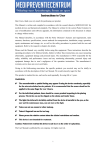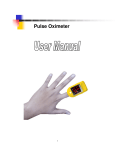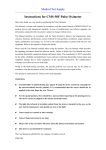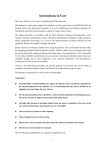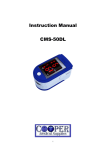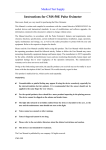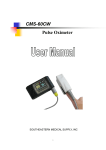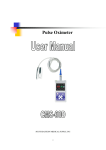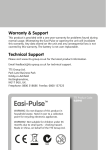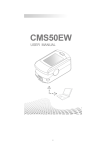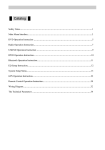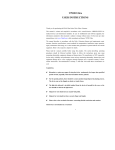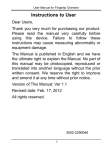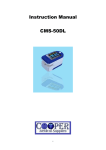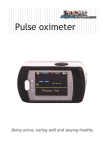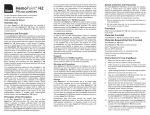Download Instructions to User 1 Safety 2 Overview 3 Principle and
Transcript
indicate the pulse intensity by the bar-display. The product is designed to be used by athletes, pilots or anyone who wants to obtain their SpO2 and pulse rate on the go. The product is not suitable for continuous use. The device is inaccurate if the user is suffering from toxicosis by carbon monoxide. The device should not be used under such circumstance. 2.4 Environment Requirements Storage Environment a) Temperature: -40°C~+60°C b) Relative humidity: ≤95% c) Atmospheric pressure: 500hPa~1060hPa Operating Environment a) Temperature: 10°C ~40°C b) Relative Humidity: ≤75% c) Atmospheric pressure:700hPa~1060hPa 3 Principle and Caution Instructions to User Dear users, thank you for purchasing the Acc U Rate® CMS 50D Pulse Oximeter. In case of modifications and software upgrades, the information contained in this document is subject to change without notice. The Manual describes, in accordance with the Pulse Oximeter's features and requirements, main structure, functions, specifications, correct methods for transportation, installation, usage, operation, repair, maintenance and storage, etc. as well as the safety procedures to protect both the user and equipment. Refer to the respective chapters for details. Please read the Manual very carefully before using this equipment. These instructions describe the operating procedures to be followed strictly. Failure to follow these instructions can lead to measurement abnormality, equipment damage and personal injury. The manufacturer is NOT responsible for the safety, reliability and performance issues and any monitoring abnormality, personal injury and equipment damage due to user's negligence of the operation instructions. The manufacturer’s warranty service does not cover such faults. Due to constant revision, the specific products you received may not be totally in accordance with the description of this User Manual. We sincerely apologize for that. WARNING: User might experience discomfort if the device is used for a prolong period of time. It is recommended that the sensor should not be applied to the same finger for over 2 hours. The device should not be clipped on tender tissue. The light (infrared is invisible) emitted from the device is harmful to the eyes. The user should not stare at the light. User should not use apply enamel or other makeup on the fingertip. Warning: Keep unit and lanyard away from children as the included lanyard may present an entanglement or choking hazard to small children. Adult supervision required; never leave children unattended with unit or lanyard The user’s fingernail should not be too long. This device is not intended to diagnose or treat any medical condition or disease. It is intended for non-medical use in healthy people to monitor their pulse and blood oxygen levels during sports and/or aviation only. People who need SpO2 and pulse rate measurements because of a medical condition should not use the device and should consult with their physician. 1 Safety 1.1 Instructions for Safe Operations Check the main unit and all accessories periodically to make sure that there is no visible damage that may affect your safety and monitoring performance. It is recommended that the device should be inspected once a week at least. When there is obvious damage, stop using the monitor. Necessary maintenance must be performed by qualified service engineers ONLY. Users are not permitted to maintain it by themselves. The oximeter should not be used together with devices not specified in User’s Manual. Only accompanied accessories should be used with this device. This product is calibrated before leaving factory. 1.2 Warnings Explosive hazard—DO NOT use the oximeter in environment with inflammable gas. Individuals who are allergic to rubber should not use this device. This pulse oximeter has no SpO2 alarms and it is not meant for continuous monitoring. The disposal of the pulse oximeters, accessories and packing material (including battery, plastic bags, foams and paper boxes) should follow local laws and regulations. Please make sure that the device and accessories are in complete accordance with the packing list, or the device might not function normally. 1.3 Attentions ֠ Keep the oximeter away from dust, vibration, corrosive substances, explosive materials, high temperature and moisture. ֠ If the oximeter gets wet, please stop operating it. ֠ When the pulse oximeter is moved from a cold environment to a warm and/or humid environment, please do not use it immediately. ֠ DO NOT operate keys on front panel with sharp materials. ֠ High temperature or high pressure steam disinfection of the oximeter is not permitted. Refer to User Manual in the relative chapter for instructions of cleaning and disinfection. ֠ Do not immerse the oximeter in liquid. When it needs cleaning, please wipe its surface with medical alcohol by soft material. Do not spray any liquid on the device directly. ֠ When cleaning the device with water, the temperature should be lower than 60°C. ֠ For fingers which are too thin or too cold, it would probably affect the normal measurement of the users' SpO2 and pulse rate. Please clip on a thicker finger such as the thumb, index or middle finger deeply into the probe. ֠ Do not use the device on infant or new born child. ֠ The product is suitable for children above four years old and adults (Weight should be between 15kg to 110kg). ֠ The device may not work for everyone. If you are unable to achieve stable readings, discontinue use. ֠ The update period of data is less than 5 seconds but might change based on different individual pulse rate. ֠ If abnormal conditions appear on the screen during the test process, pull out the finger and reinsert to restore normal use. ֠ The normal shelf life of the device is three years. ֠ The lanyard attached the product is made from non-allergic material. If you are sensitive to it, stop using it. In addition, the lanyard could present a choking hazard. Please use extreme caution when using it. ֠ The instrument does not have a low-voltage alarm function. It only shows the low-voltage on the LED screen. Please change the battery when the battery is used up. ֠ The instrument does not have alarm functions. Do not use the device in situations where alarms are required. ֠ Batteries must be removed if the device is going to be stored for more than one month, or the batteries may leak. ֠ A flexible circuit connects the two parts of the device. Do not twist or pull on the connection. 1.4 Indication for Use The Fingertip Pulse Oximeter is a non-invasive device intended for the spot-check of oxygen saturation of arterial hemoglobin (SpO2) and the pulse rate of adult and children. This device is not intended for continuous monitoring. 2 Overview SpO2 stands for peripheral capillary oxygen saturation. Oxygen saturation is defined as the ratio of oxyhemoglobin (HbO2) to the total concentration of hemoglobin (i.e. Oxyhemoglobin + reduced hemoglobin) present in the blood. It is an important physiological parameter involved in respiration and circulation. For that purpose, our company developed the Pulse Oximeter which can measure your SpO2 and pulse rate simultaneously. The Pulse Oximeter feature herein is small, portable, non-invasive and easy to use. The user only needs to insert a finger into the chamber to measure his/her SpO2 and Pulse Rate. 2.1 Features Operation of the product is simple and convenient. The product is small, light (total weight is about 50g including batteries) and easy to use. Power consumption of the product is low and the two originally equipped AAA batteries can be operated continuously for 20 hours. The product will automatically be powered off when no signal is in the product within 5 seconds. Includes Plethymosgraph to indicate strength of blood flow. Rotational OLED display for viewing convenience. 2.2 Major Applications and Scope of Application The Pulse Oximeter can be used to measure human Hemoglobin Saturation and pulse rate through finger, and 3.1 Principle of Measurement Oxygenated blood absorbs light at 660nm (red light), whereas deoxygenated blood absorbs light preferentially at 880nm (infra-red). A pulse oximeter works by passing a beam of red and infrared light through a pulsating capillary bed and then measure the amount of red and infrared light emerging from the human nail tip via a sensor. The relative absorption of light by oxyhemoglobin (HbO) and deoxyhemoglobin is then processed according to the Beer-Lambert's law and the result is a qualitative measurement of the users’ oxyhemoglobin status i.e. Oxygen saturation level (SpO2). Figure 1 Operating principle 3.2 Caution 1. The finger should be placed properly such that it is exactly in between the infra-red Emission tube and infra-red sensor (see the attached illustration of this manual, Figure 1 & 5), or else it may cause inaccurate measurement. 2. The pulse oximeter should not be used on any finger where blood flow might be restricted. For example, a limb tied with arterial canal or blood pressure cuff or receiving intravenous injection. 3. Make sure the optical path is free from any optical obstacles like rubberized fabric. 4. Excessive ambient light may affect the measuring result. It includes fluorescent lamp, dual ruby light, infrared heater, direct sunlight and etc. 5. Strenuous action of the subject or extreme electrosurgical interference may also affect the accuracy. 6. Testee cannot use enamel or other makeup on the finger. 3.3 Limitations 1. As the measurement is taken on the basis of the arteriole pulse, substantial pulsating blood flow of subject is required. For a subject with weak pulse due to shock, low ambient/body temperature, major bleeding, or use of vascular contracting drug, the pulse oximeter might not be able to take a reading. In this case, the measurement will also be more sensitive to interference. 2. For those with a substantial amount of staining dilution drug (such as methylene blue, indigo green and acid indigo blue), or carbon monoxide hemoglobin (COHb), or methionine (Me+Hb) or thiosalicylic hemoglobin, and some with icterus problem, the SpO2 determination by this monitor may be inaccurate. 3. The drugs like dopamine, procaine, prilocaine, lidocaine and butacaine may also affect the accuracy of your SpO2 levels. 4 Technical Specifications 1) Display Format: OLED Display; SpO2 Measuring Range: 0% ~ 100%; Pulse Rate Measuring Range: 30 bpm ~ 250 bpm; Pulse Wave Display: columniation display and the waveform display. 2) Power Requirements: 2×1.5V AAA alkaline battery, adaptable range: 2.6V~3.6V. 3) Power Consumption: Less than 30mA. 4) Resolution: 1% for SpO2 and 1 bpm for Pulse Rate. 5) Measurement Accuracy: ±2% in stage of 70%-100% SpO2, and meaningless when stage being smaller than 70%. ±2 bpm during the pulse rate range of 30-99 bpm and ±2% during the pulse rate range of 100~250 bpm . 7) Measurement Performance in low blood perfusion condition: SpO2 and pulse rate can be shown during low blood perfusion. However, SpO2 error is ±4%, pulse rate error is ±2 bpm or ±2% (select larger). 8) Resistance to surrounding light: The deviation between the value measured in the condition of man-made light or indoor natural light and that of darkroom is less than ±1%. 8) Equipped with a function switch. The Oximeter will automatically power off if the finger is removed after 5 seconds 9) Optical Sensor Red light (wavelength is 660nm, 6.65mW) Infrared (wavelength is 880nm, 6.75mW) 5 Accessories One hanging rope; Two AAA batteries; One silicon cover; One User Manual. 6 Installation 6.1 View of the Front Panel Figure 2 Front view Figure 3 Batteries installation Mounting the hanging rope 6.2 Battery Step 1. Refer to Figure 3 and insert two AAA size batteries properly in the right direction. Step 2. Replace the cover. Please take care when you insert the batteries. Improper insertion may damage the device. 6.3 Mounting the Hanging Rope Step 1. Put the end of the rope through the hole. Step 2. Put another end of the rope through the first one and then tighten it. 7 Operating Guide 1) Insert the two batteries properly to the direction, and then replace the cover. 2) Open the clip as shown in Figure 5. Figure 4 Figure 5 Put finger in position 3) Put your finger into the rubber cushions of the clip (make sure the finger is in the right position) and then clip the finger. 4) Press the switch button once on front panel. 5) Do not move the finger and try to keep the body stationary. 6) Get the information directly from screen display. The CMS50D Pulse Oximeter is tended for use in the electromagnetic environment specified below. The customer of the user of the CMS50D Pulse Oximeter should assure that it isused in such an environment. Emission test compliance Electromagnetic environment-guidance Group 1 7) The button RF emissions CISPR 11 The CMS50D Pulse Oximeter uses RF energy only for their internal function. Therefore, its RF emissions are very low and are not likely to cause any interference in nearby electronic equipment. RF emissions CISPR 11 Harmonic emissions IEC 61000-3-2 Voltage fluctuations/ flicker emission IEC 61000-3-3 Class B The CMS50D Pulse Oximeter is suitable for use in all establishments, including domestic establishments and those directly connected to the public low-voltage power supply network that supplies buildings used for domestic purposes. has three functions.When the device is powered off, pressing the button will power it Guidance and manufacture’s declaration –electromagnetic emission on; When the device is powered on, pressing the button quickly (<1 sec) will change the direction of the screen (See Figure 6-11), holding the button for longer than a second will change the brightness of the screen. 8) Wait for the wavelength and amplitude of the plethysmograph wave to stabilized before taking reading. Figure 6 Display mode one Figure 7 Display mode two Figure 8 Display mode three Not applicable Not applicable Guidance and manufacture’s declaration-electromagnetic immunity for all EQUIPMENT and SYSTEMS Guidance and manufacture’s declaration-electromagnetic immunity The CMS50D Pulse Oximeter is intended for use in the electromagnetic environment specified specified below. The the user of CMS50D Pulse Oximeter should assure that it is used in such an environment. Figure 9 Display mode four Figure 10 Display mode five Figure 11 Display mode six Fingernails and the luminescent tube should be on the same side. Immunity test IEC60601 test level Compliance level Electrostatic discharge (ESD) IEC 61000-4-2 ±6KV contact ±8KV air ±6KV contact ±8KV air Power frequency (50Hz) magnetic field IEC 61000-4-8 3A/m 3A/m Electromagnetic environment-guidance Floors should be wood, concrete or ceramic tile. If floor are covered with synthetic material, the relative humidity should be at least 30%. 8 Repairing and Maintenance Please change the batteries when the low-voltage symbol is displayed on the screen. Please clean the surface of the device before use. Wipe the device with medical alcohol first, and then let it dry in air or clean it by dry clean fabric. Use medical alcohol to disinfect the product after use Please take out the batteries if you are not planning to use the oximeter for a long time. The best storage environment of the device is between 10ºC to 60ºC and lower than 95% humidity. Power frequency magnetic fields should be at levels characteristic of a typical location in a typical commercial or hospital environment High-pressure sterilization cannot be used on the device. Guidance and manufacture’s declaration-electromagnetic immunity for EQUIPMENT and SYSTEMS that are not LIFE-SUPPORTING Guidance and manufacture’s declaration-electromagnetic immunity Do not immerse the device in liquid. It is recommended that the device should be kept in a dry environment. Humidity may reduce the useful life of the The CMS50D Pulse Oximeter is intended for use in the electromagnetic environment specified below. The customer or the user of CMS50D Pulse Oximeter should assure that it is used in such an environment. device, or even damage it. 9 Troubleshooting Trouble Possible Reason Solution The SpO2 and Pulse Rate cannot be displayed normally 1. The finger is not properly positioned. 2. The user’s SpO2 is too low to be detected. 1. Place the finger properly and try again. 2.Try again; Make sure nothing is impeding your blood flow The SpO2 and Pulse Rate values change erratically 1. The finger is not placed deep enough into the device. 2. The finger or the user is moving. 1. Place the finger properly and try again. 2. Keep stationary as much as possible during measurement The device cannot be turned on 1. The batteries are drained or almost drained. 2. The batteries are not inserted properly. 3. The malfunction of the device. 1. Change batteries. 2. Reinstall batteries. 3. Please contact the local service center. The display turns off suddenly 1. The device will power off automatically if the finger is withdrawn after 5 seconds. 2. The batteries are almost drained. 1. Press the power button to turn it back on. 2. Change batteries. Immunity test IEC60601 test level Compliance level Radiated RF ICE 61000-4-3 3V/m 80MHz 2.5GHz 3V/m Portable and mobile RF communication equipment should be used no closer to any part of the CMS50D Pulse Oximeter, including cables, than the recommended separation distance calculated from the equation applicable to the frequency of the transmitter. recommended separation distance to 10 Key of Symbols Symbol Description Type BF Warning – See User Manual 3.5 d= P E1 80MHz to 800MHz 7 d = P E1 800MHz to 2.5GHz Where P is the maximum output power rating of the transmitter in watts (W) according to the transmitter manufacturer and d is the recommended separation distance in meters (m). Field strengths from fixed RF transmitters, as determined by an electromagnetic site survey, a should be less than the compliance level in each frequency range.b Interference may occur in the vicinity of equipment marked with the following symbol: Blood oxygen saturation (%) PRbpm Electromagnetic environment -guidance Pulse rate (bpm) The battery voltage indication is deficient (change the battery in time avoiding the inexact measure) 1. no finger inserted 2. An indicator of signal inadequacy battery positive electrode NOTE 1 At 80MHz and 800MHz, the higher frequency range applies. NOTE 2 These guidelines may not apply in all situations. Electromagnetic propagation is affected by absorption and reflection from structures, objects and people. battery cathode 1.Power switch 2.change direction of the screen 3.Change brightness of the screen SN a Field strengths from fixed transmitters, such as base stations for radio (cellular/cordless) telephones and land mobile radios, amateur radio, AM and FM radio broadcast and TV broadcastcannot be predicted theoretically with accuracy. To assess the electromagnetic environment due to fixed RF transmitters, an electromagnetic site survey should be considered. If the measured field strength in the location in which The CMS50D Pulse Oximeter is used exceeds the applicable RF compliance level above, the CMS50D Pulse Oximeter should be observed to verify normal operation. If abnormal performance is observed, additional measures may be necessary, such as reorienting or relocating the CMS50D Pulse Oximeter. b Over the frequency range 150 KHz to 80 MHz, field strengths should be less than 3V/m. Serial number Alarm inhibit WEEE (2002/96/EC) IP22 International Protection This item is compliant with Medical Device Directive 93/42/EEC of June 14, 1993, a directive of the European Economic Community. However, this is not a medical device and is not intended to diagnose or treat any medical condition or disease. 11 Function Specification Recommended separation distances between portable and mobile RF communications equipment and the EQUIPMENT or SYSTEM for EQUIPMENT or SYSTEM that not LIFE-SUPPORTING Recommended separation distances between portable and mobile RF communications equipment and the CMS50D Pulse Oximeter Display Information The Pulse Oxygen Saturation (SpO2) Display Mode OLED Pulse Rate (PR) OLED Pulse Intensity (bar-graph) OLED bar-graph display Pulse wave OLED SpO2 Parameter Specification Measuring range 0%~100%, (the resolution is 1%). Accuracy 70%~100%:±2%, Below 70% unspecified. Optical Sensor Red light (wavelength is 660nm) Infrared (wavelength is 880nm) Rated maximum output power of transmitter (W) 30bpm~250bpm (the resolution is 1 bpm) ±2bpm or±2% select larger Pulse Parameter Specification Measuring range Accuracy Pulse Intensity Range Continuous bar-graph display. Increased height indicates stronger pulse. Battery Requirement 1.5V (AAA size) alkaline batteries × 2 or rechargeable battery Battery Useful Life Two batteries can work continuously for 20 hours Dimensions and Weight Dimensions Weight 57(L) × 31(W) × 32(H) mm About 50g (with the batteries) Appendix Guidance and manufacture’s declaration-electromagnetic emission for all EQUIPMENT and SYSTEMS The CMS50D Pulse Oximeter is intended for use in the electromagnetic environment in which radiated RF disturbances are controlled. The customer or the user of the CMS50D Pulse Oximeter can help prevent electromagnetic interference by maintaining a minimum distance between portable and mobile RF communications equipment (transmitters) and the CMS50D Pulse Oximeter as recommended below, according to the maximum output power of the communications equipment. Separation distance according to frequency of transmitter (m) 150KHz to 80MHz 80MHz to 800MHz 800MHz to 2.5GHz 7 d = P E1 3.5 d = P E1 3 .5 d= P E1 0.01 0.12 0.12 0.23 0.1 0.37 0.37 0.74 1 1.17 1.17 2.33 10 3.69 3.69 7.38 100 11.67 11.67 23.33 For transmitters rated at a maximum output power not listed above, the recommended separation distanced in meters (m) can be estimated using the equation applicable to the frequency of the transmitter, where P is the maximum output power rating of the transmitter in watts (W) according to the transmitter manufacturer. NOTE 1 At 80MHz and 800MHz, the separation distance for the higher frequency range applies. NOTE 2 These guidelines may not apply in all situations. Electromagnetic propagation is affected by absorption and reflection from structures, objects and people.


